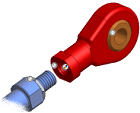iMates can be defined and used in iParts and iAssemblies.

When used together, iMates and iParts and iAssemblies make it easy to insert and constrain multiple members from factories in assemblies.
Define one half of a constraint pair in a part or assembly (iMate). This definition tells the component how to connect to another component with the corresponding iMate when inserted in an assembly. You can also define one half of the constraint pair limits to set the allowable range of motion.
An iPart or iAssembly factory defines members in rows in a table or an embedded spreadsheet. Even though some parameters differ for individual members, they can still fit together using the same iMate constraint pairs.
An iPart factory defines members in rows in a table or an embedded spreadsheet. Even though some parameters differ for individual members, they can still fit together using the same iMate constraint pairs.
How are iMates specified in iParts and iAssemblies?
An iMate placed in an iPart or iAssembly factory can be included in all members generated from the factory. On the iMates tab of the author dialog box, you can select properties of the iMate to include in members. For example, you can select its matching name or sequence number, and then stipulate whether it is used for individual members, as needed. Each selected property creates a column in the table.
If you suppress (iPart) or exclude (iAssembly) an iMate in a factory or member, it is not created. All members in which the iMate is not suppressed or excluded include them in generated files.
If you suppress an iMate in a factory or member, it is not created. All members in which the iMate is not suppressed includes them in generated files.
How can iMates be modified in an iPart or iAssembly factory?
When you create an iPart or iAssembly, you can modify values in the factory table, including iMates. For each member in the factory table, you can modify:
- Offset value
- Maximum and minimum limit value
- Suppression state (on or off)
- Sequence number
- Matching name (in the match list)
- iMate name